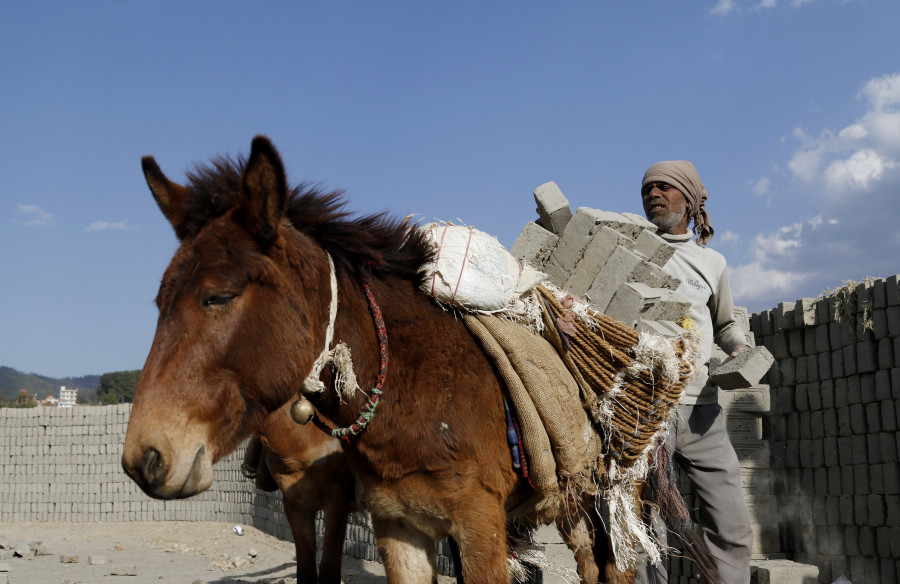National
Plan to replace foreign workers with Nepalis in various sectors is easier said than done
At a time when many Nepalis have lost jobs to the pandemic, a comprehensive strategy could ensure work for them at home, officials and experts say.
Prithvi Man Shrestha
Just before the lockdown began in the third week of March to contain the spread of the coronavirus, Umesh Prasad Singh had more than 400 Indian seasonal workers at his two brick factories at Tarapatti Sirsiya, Dhanusha. He had employed 300 Nepali workers as well.
His brick factories have remained shut since the nationwide lockdown was imposed on March 24. Although the lockdown was lifted on July 21, his factories have failed to resume operations, as most of the workers who had returned home have not come back.
“I am waiting for them to come back,” Singh said. “Most Nepalis do not want to work at a brick factory.”
Singh, who is also the acting president of the Federation of Nepalese Cottage and Small Industries, employs Indian workers at his dairy and hosiery factory as well.
While factories like Singh’s are falling short of hands, Nepalis in hordes are heading for India to work.
Though the Nepal government has been saying it aims to have Nepalis work in enterprises deserted by foreign workers, it has not formulated any strategy yet.
Bharatmani Pandey, spokesperson for the Ministry of Labour, Employment and Social Security, said there is a general policy to ensure that more Nepalis are employed instead of foreign workers but no specific strategy has been made yet.
The pandemic has rendered hundreds of thousands jobless–from casual daily wage-earners to the people involved in the tourism sector to those engaged in teaching profession.
According to an International Labour Organisation report, between 1.6 million to 2 million jobs are likely to be disrupted in Nepal in the current crisis either with complete job losses or reduced working hours and wages.
A Nepal Rastra Bank survey showed 22.5 percent of industries cut down their employees, mainly temporary staff, while deducting wages by 18.2 percent on average. The cut-down in the tourism sector alone affected over one million employment.
Then there are those Nepali migrant workers who have lost their jobs and are returning home.
Outgoing Finance Minister Yubaraj Khatiwada had repeatedly said that the country could use the domestic workforce to replace Indian workers in construction and manufacturing sectors.
The federal government’s budget for the current fiscal year 2020-21 has focussed on creating jobs, and it plans to generate around 700,000 new jobs.
The government plans to create these jobs through various programmes and initiatives including the Prime Minister Employment Programme launched in January 2018.
The Prime Minister Employment Programme to be implemented through provincial and local governments aims to provide employment for 100 days to 200,000 marginalised people across the country.
The federal government also plans to create jobs under the food for work programme, small farmers credit programme, various skill training schemes, and encouraging industries to employ listed unemployed people in employment service centres and strictly implementing work permits for foreign workers.
A budget of Rs11.6 billion has been set aside for this in the current fiscal year, up from Rs 5.01 billion in the last fiscal year 2019-20 when it provided employment for 60,000 people.
The government’s lack of planning before Khatiwada’s call for replacing foreign workers with Nepali is also clear from the fact that there is no record of the number of foreign workers in the country.
“We only have data on foreigners who are employed in the formal sector for whom we issue work permits,” said Pandey. “But there is no data on the large proportion of foreign workers, particularly Indian nationals employed in the informal sector.”
According to the Department of Labour and Occupational Safety, only 77 Indians have received permits to work in Nepal since January 2017.
It may not be known how many Indians work in Nepal in the non-formal sector but according to the Washington-based Pew Research Centre, Indian workers sent $2.7 billions from Nepal in 2015 making Nepal the ninth highest remittance sending countries to India.
There are a number of reasons why Nepali employers give jobs to Indian nationals and they may not be easy to replace.
“In large industries, skilled labourers, including machine operators, are Indians. They make up 15-20 percent of the workers in large industries in the Sunsari-Morang Industrial Corridor,” said Bhim Ghimire, president of Chambers of Industries, Morang. “Many large industries in the Sunsari-Morang Industrial Corridor employ skilled and semi-skilled Indian workers.”
Former vice-chairman of National Planning Commission Shankar Sharma does not see an easy route to replace foreign workers with Nepali workers in Nepal in the manufacturing sector due to lack of proper skills with Nepali workforce.
“It is because our workers are not getting quality training,” Sharma told the Post. “We need to prepare good quality trainers and employ international certifying agencies to provide certificates for the skills.”
According to him, several training programmes launched so far have proven to be ineffective.
Besides, it is also easier for factory owners to employ foreigners because they need not strictly follow labour laws in their case and don’t have to grant them leave for different festivals and family rituals.
A large number of foreign workers are employed in the construction sector as well.
According to the Federation of Contractors’ Association of Nepal, one-third of the total 1.5 million construction workers employed annually in Nepal are foreigners, including Indians, Bangladeshis and Chinese.
Building contractors too, like Singh, the brick factory operator, prefer Indian workers.
“Contractors would be happy to employ foreign workers, particularly Indian nationals, because they are more committed than Nepalis to work,” said Rabi Singh, president of the federation. “It is also less costly for contractors to employ Indian workers.”
After the lockdown, most of the foreign workers went home as jobs dried.
According to Sharma, the former vice-chair of the planning commission, the government could take certain restrictive measures to discourage employers from hiring foreign workers in the construction sector.
“The contractors subcontract the task of bringing workers and they bring foreign workers to the construction site,” he said. “If the government imposes certain fees on contractors for hiring foreign workers, such tendencies will be discouraged. This is the practice many countries have adopted.”
Officials, however, say drastic moves to prevent Nepali employers from bringing in foreign workers, especially those from India, can have some diplomatic issues.
“Making provisions like mandatory work permits for Indians to work in Nepal could discourage them from coming to Nepal,” said Pandey, the spokesman. “But we should not forget the fact that many Nepalis are also working in India without work permits.”




 12.12°C Kathmandu
12.12°C Kathmandu













%20(1).jpg&w=300&height=200)

